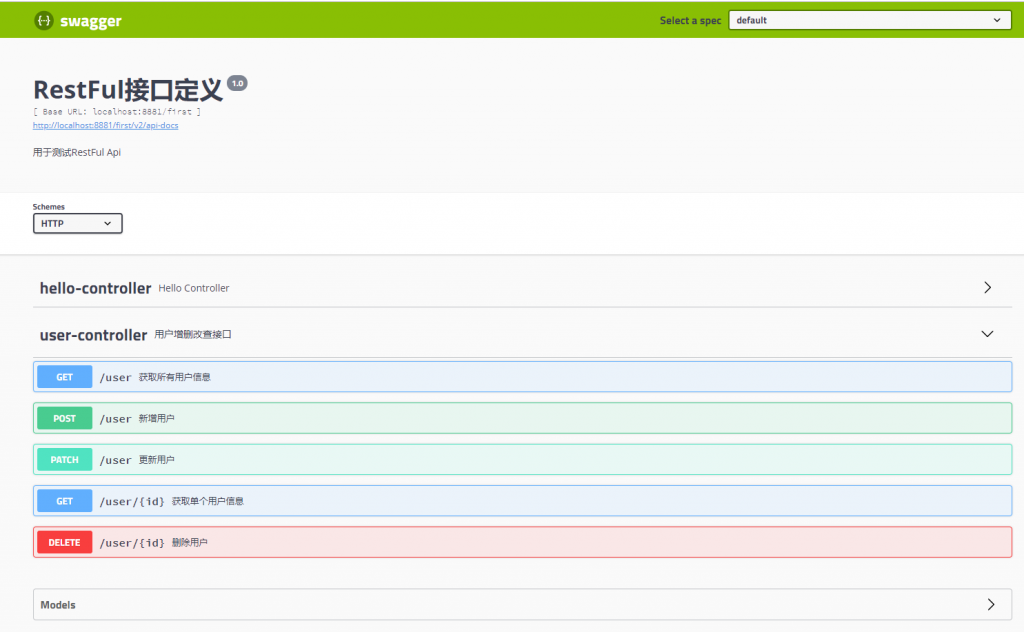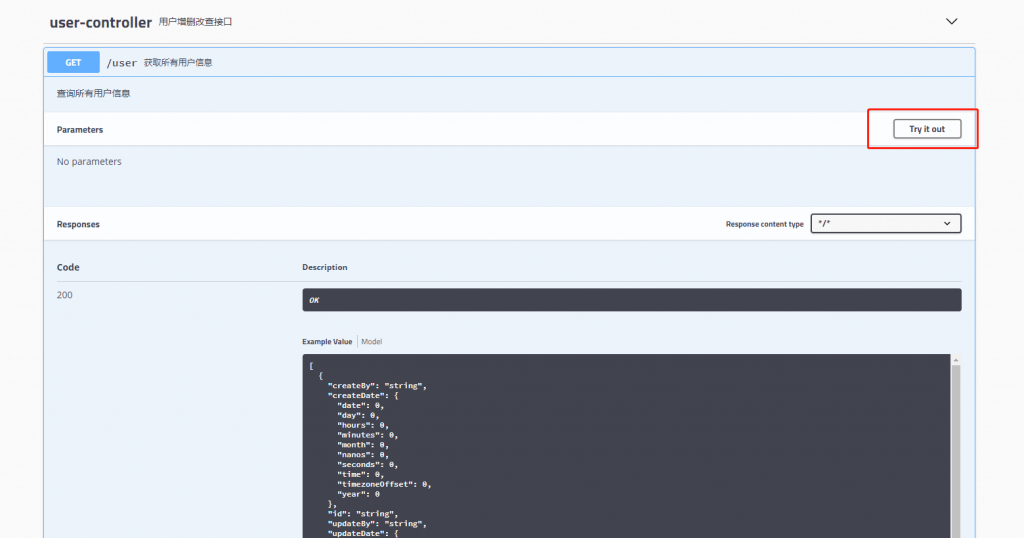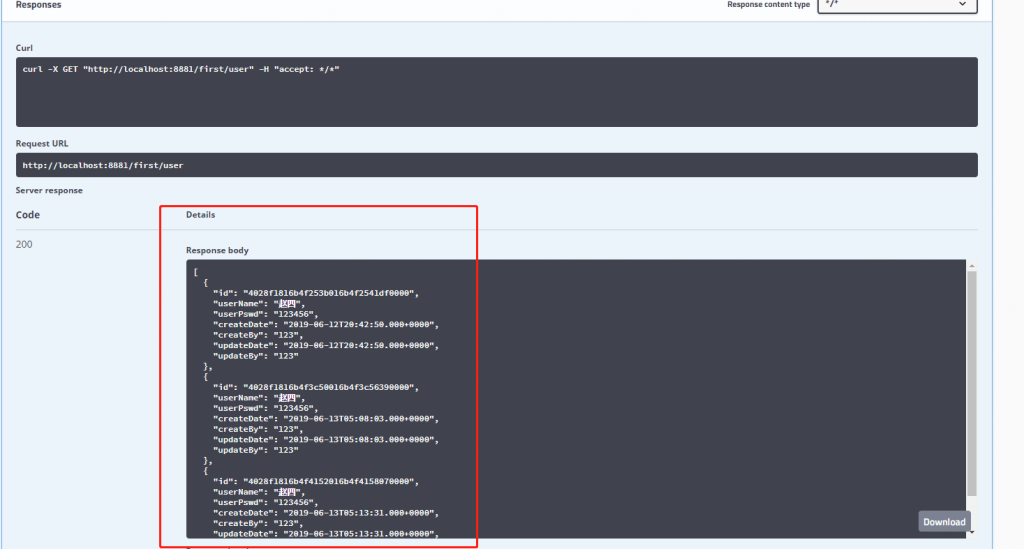上一节主要讲了SpringBoot集成jpa对mysql数据库进行增删改查操作,写了有五个接口,不管是用postman还是用单元测试对于调试接口都不是很方便,一方面得记住接口地址,一方面还得知道接口的参数格式,在前后端分离的趋势下,如果后端接口变更前端如何第一时间就能发现呢,这时候swagger就应用而生。
swagger出现的目的是为了给SpringMvc的controller实现Api文档的在线生成以及接口的在线调试,这样即使接口发生任何改动和变化,在swagger的可视化界面中都能很快的发现,对于调试接口是十分便利的
springBoot如何快速集成这么一款优秀的框架呢?集成过程也是十分简单的,大概分这么几个步骤。
目录
1、添加Swagger的依赖
在上一节的项目pom.xml文件中最后面追加swagger的依赖,总共有两个依赖包。

swagger依赖代码,依赖完成后,idea右下角会提示导入,点击导入。
<!-- swagger2集成 -->
<dependencies>
.....
<dependency>
<groupId>io.springfox</groupId>
<artifactId>springfox-swagger2</artifactId>
<version>2.9.2</version>
</dependency>
<!-- swagger2集成 -->
<dependency>
<groupId>io.springfox</groupId>
<artifactId>springfox-swagger-ui</artifactId>
<version>2.9.2</version>
</dependency>
</dependencies>
2、编写Swagger的配置文件
在项目com.apgblogs.firstspringboot包下创建一个config的包,这个包主要用来存放一些第三方框架集成需要的配置类,对于配置的一些属性含义会在视频教程中详细说明

package com.apgblogs.firstspringboot.config;
import com.google.common.collect.Sets;
import org.springframework.context.annotation.Bean;
import org.springframework.context.annotation.Configuration;
import springfox.documentation.builders.ApiInfoBuilder;
import springfox.documentation.builders.PathSelectors;
import springfox.documentation.builders.RequestHandlerSelectors;
import springfox.documentation.service.ApiInfo;
import springfox.documentation.spi.DocumentationType;
import springfox.documentation.spring.web.plugins.Docket;
import springfox.documentation.swagger2.annotations.EnableSwagger2;
/**
* @author xiaomianyang
* @description
* @date 2019-05-15 00:14
*/
@Configuration
@EnableSwagger2
public class Swagger2 {
@Bean
public Docket createRestApi() {
return new Docket(DocumentationType.SWAGGER_2)
.protocols(Sets.newHashSet("http")) //协议,http或https
.apiInfo(apiInfo())
.select()
.apis(RequestHandlerSelectors.basePackage("com.apgblogs.firstspringboot.controller")) //controller扫描路径
.paths(PathSelectors.any())
.build();
}
private ApiInfo apiInfo() {
return new ApiInfoBuilder()
.title("RestFul接口定义")
.version("1.0")
.description("用于测试RestFul Api")
.build();
}
}
3、在UserController中加入Swagger的注解,实现Api接口可视化调试
package com.apgblogs.firstspringboot.controller;
import com.apgblogs.firstspringboot.entity.TUserEntity;
import com.apgblogs.firstspringboot.service.UserServiceImpl;
import io.swagger.annotations.Api;
import io.swagger.annotations.ApiImplicitParam;
import io.swagger.annotations.ApiImplicitParams;
import io.swagger.annotations.ApiOperation;
import org.springframework.beans.factory.annotation.Autowired;
import org.springframework.web.bind.annotation.*;
import java.util.List;
/**
* @author xiaomianyang
* @description
* @date 2019-06-13 15:54
*/
@Api(description = "用户增删改查接口")
@RestController
@RequestMapping("user")
public class UserController {
@Autowired
private UserServiceImpl userService;
/**
* @description 查询所有用户
* @author xiaomianyang
* @date 2019-06-13 16:05
* @param []
* @return java.util.List<com.apgblogs.firstspringboot.entity.TUserEntity>
*/
@ApiOperation(value="获取所有用户信息",notes = "查询所有用户信息")
@GetMapping
public List<TUserEntity> getAllUser(){
return userService.getUserList();
}
/**
* @description 获取单个用户
* @author xiaomianyang
* @date 2019-06-13 16:05
* @param [id]
* @return com.apgblogs.firstspringboot.entity.TUserEntity
*/
@ApiOperation(value="获取单个用户信息",notes="通过用户id查询用户信息")
@ApiImplicitParam(name = "id",value="用户id",required = true,paramType = "path",dataType = "String")
@GetMapping("{id}")
public TUserEntity getUser(@PathVariable("id")String id){
return userService.getUser(id);
}
/**
* @description 创建用户
* @author xiaomianyang
* @date 2019-06-13 16:05
* @param [tUserEntity]
* @return com.apgblogs.firstspringboot.entity.TUserEntity
*/
@ApiOperation(value="新增用户",notes = "新增用户")
@PostMapping
public TUserEntity insertUser(@RequestBody TUserEntity tUserEntity){
return userService.insertUser(tUserEntity);
}
/**
* @description 更新用户
* @author xiaomianyang
* @date 2019-06-13 16:05
* @param [tUserEntity]
* @return com.apgblogs.firstspringboot.entity.TUserEntity
*/
@ApiOperation(value="更新用户",notes = "修改用户部分信息")
@PatchMapping
public TUserEntity updateUser(@RequestBody TUserEntity tUserEntity){
return userService.updateUser(tUserEntity);
}
/**
* @description 删除用户
* @author xiaomianyang
* @date 2019-06-13 16:13
* @param [id]
* @return boolean
*/
@ApiOperation(value="删除用户",notes = "通过id删除用户")
@ApiImplicitParam(name = "id",value="用户id",required = true,paramType = "path",dataType = "String")
@DeleteMapping("{id}")
public boolean deleteUser(@PathVariable("id")String id){
userService.deleteUser(id);
return true;
}
}
启动项目
4、在浏览器访问Swagger的接口可视化地址并调试
swagger访问地址: http://localhost:8881/first/swagger-ui.html ,访问成功后在浏览器中就可以看到如下所示的界面

可以点击其中一个接口进行测试,点击获取所有用户接口

点击Try it out,点击Execute

返回了所有用户数据如下

5、文章源码地址
码云: https://gitee.com/apgblogs/springBootStudy
至此就完成了springBoot对于swagger的集成,只要所有的controller都加入了swaggr的注解就可以轻松实现在线Api文档的生成。